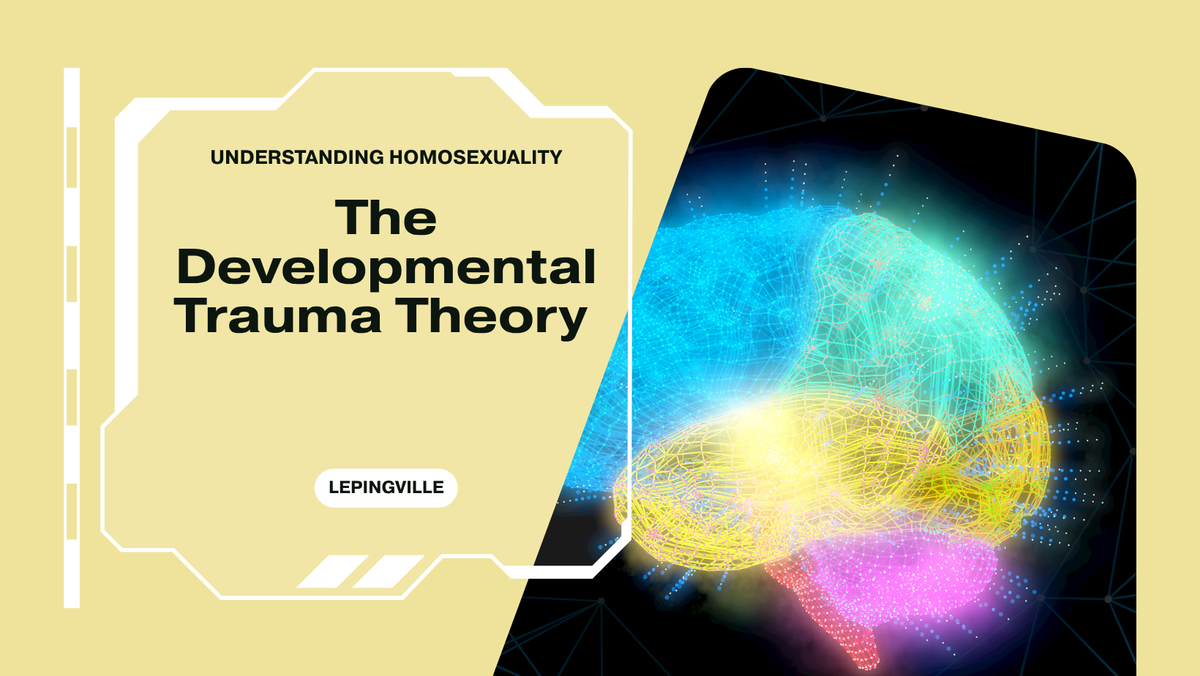The Developmental Trauma Theory

An analysis of psychoanalytic research revealing consistent patterns of childhood disruption in male homosexual development
The Foundation
In 1962, a team of researchers from the Society of Medical Psychoanalysts completed what would become one of the most significant studies in the history of sexual orientation research. Led by Dr. Irving Bieber, this nine-year investigation of 106 homosexual men revealed a startling consistency in their developmental backgrounds—a finding that would reshape understanding of human psychosexual development and challenge prevailing assumptions about the immutability of sexual orientation.
The study didn't emerge in isolation. It built upon decades of psychoanalytic observation and theory, beginning with Sigmund Freud's insight that adult personality and sexual patterns are forged in the crucible of early childhood development. But where Freud saw homosexuality as a normal developmental phase that some individuals failed to outgrow, his successors discovered something far more specific: a precise pattern of family dysfunction that appeared to manufacture same-sex attraction with disturbing regularity.
The Rado Revolution
The theoretical foundation for trauma-causation research was established by Hungarian psychoanalyst Sandor Rado in his 1940 paper "A Critical Examination of the Concept of Bisexuality." Rado rejected Freud's theory of innate bisexuality, arguing instead that "heterosexuality was the only biological norm and homosexuality reconceptualized as a 'phobic' avoidance of the other sex caused by inadequate parenting."
Rather than viewing homosexuality as a constitutional variation or developmental arrest, Rado's framework positioned it as a specific response to environmental trauma, a defensive adaptation to family pathology that disrupted normal psychosexual development. This theory would prove prophetic as clinical evidence accumulated over the following decades.
The Bieber Breakthrough
The Bieber study's findings were as clear as they were consistent. Among the 106 homosexual men examined, a distinct family pattern emerged with mathematical precision:
The Maternal Dynamic: "The mother forms an overly close bond with her homosexual son. She tends to dominate and restrict him and she discourages his assertiveness. Most such mothers are close, binding and intimate (CBI), sometimes in sexually inappropriate ways. This son is usually her favourite whom she openly prefers to her husband."
The Paternal Absence: "The fathers are hostile, competitive and do nothing to neutralize deleterious maternal influences." These men were described as "detached and rejecting," creating a vacuum in masculine identification precisely when the developing boy most needed a strong male figure.
The Toxic Triangle: "Within the family system, the CBI mother and son form a romantically tinged dyad, while the father and other siblings remain on the periphery. The son develops a profound dependency on the mother who often remains the most beloved person and focus of his life."
The study revealed that when these specific family dynamics occurred during critical developmental periods, they created a psychological environment that systematically produced homosexual orientation.
The Bieber findings weren't isolated. Independent researchers across different populations confirmed the same family constellation. West's 1959 study of hospitalized patients found that "the combination of an over-intense relationship with the mother and an unsatisfactory relationship with the father is typical for the homosexual." Additional research showed that "homosexuals described their fathers and mothers as more rejecting and less loving and that they were less close to their fathers than heterosexuals."
The pattern transcended clinical settings. Studies of seminary students, a population presumably less likely to seek psychiatric treatment, revealed that "seminarians who identified their sexual orientation as homosexual scored significantly lower on their level of intimacy with their fathers than did heterosexual seminarians."
The Developmental Mechanism
The psychoanalytic understanding of sexual development provides the mechanistic framework for understanding how family trauma translates into homosexual orientation. According to Freudian theory, healthy psychosexual development requires successful navigation of specific stages, particularly the phallic phase (ages 3-6) when "the complex is the boy's phallic stage formation of a discrete sexual identity."
During this critical period, the boy must accomplish two essential tasks:
- Disidentification from mother: Breaking the early symbiotic bond to develop autonomous masculine identity
- Identification with father: Internalizing masculine characteristics through positive paternal modeling
When hostile, absent, or weak fathers fail to provide this identification opportunity, while simultaneously domineering mothers prevent healthy separation, the boy's masculine development becomes arrested. The resulting psychological structure seeks to repair this deficit through sexualized contact with males, an unconscious attempt to obtain the masculine connection that was disrupted in early development.
As contemporary researcher Joseph Nicolosi explained: "Homosexuality is an adaptation to trauma; it is rooted in a same-sex attachment problem that leaves the boy alienated from his masculine nature." The sexual attraction represents a "reparative drive" attempting to heal the original wound.
The Trauma Evidence
The family dysfunction identified in psychoanalytic research creates specific vulnerabilities that manifest in dramatically elevated trauma rates among homosexual men:
- Studies consistently show that 35-46% of gay and bisexual men report childhood sexual abuse, compared to only 7% of heterosexual men
- Research reveals that 37% of homosexual men "reported they had been encouraged or forced to have sexual contact before age 19 with an older or more powerful partner"
- Data indicates that "46% of homosexual men in contrast to 7% of heterosexual men reported homosexual molestation"
These represent a systematic pattern of vulnerability created by the same family dynamics that disrupt normal sexual development. Children who display gender nonconformity (often a result of failed masculine identification) become targets for predatory behavior, creating additional trauma that further compounds the original developmental disruption.
Research has identified a crucial link between early family trauma, gender nonconformity, and subsequent victimization. Studies show that "children who appear to be different from typical children are at higher risk of being targeted" for sexual abuse, and "sexual predators may similarly target gender nonconforming children."
The mechanism is straightforward: boys who fail to develop secure masculine identification due to family dysfunction often display feminine characteristics that make them stand out to potential abusers. This creates a vicious cycle where initial developmental trauma leads to gender nonconformity, which increases vulnerability to sexual abuse, which further disrupts normal psychosexual development.
As researchers noted: "Gender nonconforming children are at higher risk of being targeted" because "individuals who display gender nonconforming behavior are more likely to be targets for rejection, discrimination, victimization, and physical abuse than their gender-conforming counterparts."
Therapeutic Success
The therapeutic success rates documented in psychoanalytic literature represent one of the most compelling pieces of evidence for the trauma-causation theory. The Bieber study's reported 27% cure rate was not an isolated finding but part of a broader pattern of clinical success that extended across multiple practitioners and institutions.
Dr. Charles Socarides, one of the leading figures in homosexuality treatment, reported similar success rates throughout his decades of clinical practice. His approach focused on resolving the underlying mother-son pathological bond and helping patients develop authentic masculine identification. Socarides documented cases where patients who had been exclusively homosexual for years developed stable heterosexual relationships and marriages after working through their childhood trauma.
Contemporary practitioners have continued this work with modern refinements. Joseph Nicolosi Sr., founder of the National Association for Research and Therapy of Homosexuality (NARTH), assisted "over a thousand clients with their goal to reduce their same-sex attractions and explore their heterosexual potential." His clinical approach, known as Reparative Therapy, built directly on the psychoanalytic foundation while incorporating newer understanding of attachment theory and trauma resolution.
The therapeutic mechanism involves systematic work to address what Nicolosi termed the "reparative drive," the unconscious attempt to obtain masculine connection through sexualized contact with men. By helping clients understand that their same-sex attractions represented an attempt to repair early developmental wounds, therapists could guide them toward healthier ways of meeting those underlying needs.
Client testimonials from Nicolosi's practice reveal the profound nature of these changes. One client, Mohammed, a 28-year-old graduate student from Cairo, described finding Nicolosi's work "at a time when my life was really dark, really painful. I could not stand my same-sex attractions." Another client, Bill, who worked with Nicolosi for three years, became "an orthopedic surgeon" and successfully developed heterosexual capacity.
The success wasn't limited to individual practitioners. Former American Psychological Association President Nicholas Cummings, during his years as Chief Psychologist at Kaiser Permanente in San Francisco, stated: "Of the patients I oversaw who sought to change their orientation, hundreds were successful." This represents systematic success across a major healthcare institution, not isolated clinical reports.
The therapeutic process typically involved several phases: first, helping clients understand the connection between their childhood experiences and current attractions; second, working through the specific trauma and family dynamics that created the developmental arrest; third, facilitating healthy masculine identification and emotional growth; and finally, supporting the emergence of natural heterosexual capacity.
Research by Nicolosi, Byrd, and Potts documented these outcomes systematically, showing that clients who underwent reparative therapy experienced "changes in homosexual orientation" with many developing "heterosexual potential." The study found that therapeutic intervention could modify the underlying psychological structures that generated same-sex attraction.
Cross-Cultural Consistency
The trauma-causation model gains extraordinary credibility from its consistent appearance across radically different cultural contexts. Research from China reveals that "sexual minority men have reported a higher prevalence of family maltreatment during childhood, especially sexual abuse," despite China's very different cultural attitudes toward family structure and sexuality compared to Western societies.
Chinese researchers found that "children who had disclosed their same-sex orientation to their family members could be targeted for physical and verbal abuse," and that "homosexuality was regarded as a kind of 'hooliganism' until the law was removed in 1997." Yet even in this dramatically different cultural context, the same family patterns emerged: distant or hostile fathers, overly close maternal relationships, and elevated rates of childhood trauma.
Studies from Latin American countries revealed similar patterns. Research among Latino men found that "gender nonconformity, homophobia, and mental distress" were interconnected, with participants linking "their childhood physical and sexual abuse experiences to homophobia among family members." This means that regardless of specific cultural expressions, the underlying family dynamics operate according to universal psychological principles.
International research has identified what scholars term "harmful cultural practices" that systematically target gender-nonconforming children. Studies document phenomena like the "dancing boys" of South Asia, where children "who exhibit feminine characteristics are frequently exposed to the risk of sexual violence." These practices exist across multiple cultures and represent institutionalized targeting of precisely the children who, according to the trauma-causation theory, are most vulnerable due to disrupted gender development.
African research has revealed elevated rates of childhood sexual abuse among men who have sex with men, despite cultural contexts that are dramatically different from Western societies. Studies found that "Black and Hispanic men were more likely than white men to report such sexual contact," suggesting that the vulnerability patterns transcend racial and cultural boundaries.
European studies have documented the same family constellation across different national contexts. Research from the Netherlands, Denmark, and the United Kingdom consistently shows higher rates of "childhood abuse and gender nonconformity" among sexual minority populations, despite these countries having very different historical attitudes toward homosexuality and family structure.
Perhaps most significantly, studies of traditional societies with limited Western influence show similar patterns. Anthropological research has documented that in cultures with strict gender role enforcement, children who display gender nonconformity face systematic targeting and abuse, often leading to adult same-sex orientation patterns that mirror those found in Western clinical populations.
The cross-cultural consistency extends to therapeutic outcomes as well. Reports from practitioners in different countries describe similar success rates when working with clients using trauma-resolution approaches. This means that the underlying psychological mechanisms operate independently of cultural attitudes toward homosexuality itself.
How Environment Shapes Biology
The trauma-causation theory doesn't contradict biological research but rather explains how environmental factors create the biological differences observed in homosexual populations. Modern neuroscience has revealed that severe psychological trauma during critical developmental periods can literally reshape brain structure, hormonal patterns, and even genetic expression through epigenetic mechanisms.
Research on adverse childhood experiences (ACEs) demonstrates that early trauma fundamentally alters neurobiological development. Studies show that children who experience the specific types of family dysfunction identified in homosexual development, emotional abuse, neglect, sexual trauma, develop measurable changes in brain regions associated with stress response, emotional regulation, and social bonding.
The timing of these interventions is crucial. During what researchers call "critical periods" of psychosexual development, particularly ages 3-6 when gender identity consolidates, traumatic experiences can permanently alter the neural pathways that govern sexual attraction and gender identification. This explains why the family dynamics identified in the Bieber study have such lasting effects, they occur precisely when the brain is most malleable and sensitive to environmental input.
Epigenetic research has revealed how psychological trauma can modify gene expression without changing the underlying DNA sequence. Studies suggest that "epigenetic mechanisms could influence male sexual orientation" by altering how genes related to sexual development are activated or suppressed. This means that environmental trauma can create biological changes that are then inherited by subsequent generations, potentially explaining patterns of homosexuality within family lineages.
The concept of "gene-environment interaction" helps explain why some children exposed to traumatic family dynamics become homosexual while others don't. Research suggests that certain children may be born with "biological conditions (prenatal hormonal influences, inborn emotional sensitivity) that make them especially vulnerable to such trauma." These biological predispositions don't cause homosexuality directly but create heightened sensitivity to specific environmental triggers.
Studies of brain structure in homosexual men have found differences in regions associated with emotional processing and social bonding, precisely the areas most affected by early attachment trauma. Rather than representing innate differences, these findings may reflect the neurobiological consequences of the specific family dynamics documented in psychoanalytic research.
Hormonal research supports this environmental influence model. Studies show that chronic stress during childhood, such as would result from the hostile father relationships and engulfing maternal bonds described in clinical literature, can permanently alter hormonal systems, including those that regulate sexual behavior and attraction patterns.
The "fraternal birth order effect," where each older brother increases the probability of homosexuality by about 33%, may also operate through trauma mechanisms rather than purely biological ones. Research suggests this effect might result from "progressive immunization of the mother" against male-specific proteins, but it could equally reflect changing family dynamics as mothers become increasingly focused on male children at the expense of developing healthy father-son relationships.
Why This Research Disappeared
The suppression of trauma-causation research represents one of the most successful ideological capture campaigns in modern scientific history. The process began in the early 1970s when gay rights activists, rather than addressing the clinical evidence on its merits, chose to pursue a political strategy aimed at eliminating homosexuality as a psychiatric category entirely.
The pivotal moment came in 1973 when the American Psychiatric Association voted to remove homosexuality from the Diagnostic and Statistical Manual of Mental Disorders (DSM). This decision was not based on new scientific evidence contradicting the extensive clinical literature, but resulted from sustained political pressure and activism. As participants later acknowledged, the vote was influenced more by political considerations than scientific data.
Dr. Charles Socarides, one of the leading researchers in homosexuality treatment, was excluded from this process despite his decades of clinical experience and published research. The organizers of the 1973 decision deliberately avoided engaging with the clinical evidence that Socarides, Bieber, and others had accumulated, instead framing the issue in terms of civil rights rather than scientific investigation.
The suppression campaign extended beyond the psychiatric establishment to academic institutions more broadly. Researchers who continued to investigate family dynamics and therapeutic approaches found themselves facing institutional pressure, funding difficulties, and professional ostracism. The message was clear: certain research directions were no longer acceptable regardless of their scientific merit.
NARTH (National Association for Research and Therapy of Homosexuality), founded in 1992 by Joseph Nicolosi, Charles Socarides, and Benjamin Kaufman, represented an attempt to preserve the clinical tradition in the face of this suppression. However, the organization faced sustained attack from activists who characterized its work as "junk science" and pressured professional organizations to condemn its members.
The Southern Poverty Law Center specifically targeted NARTH as "a main source of junk science used by hate groups to justify anti-gay rhetoric," despite the organization's secular, scientific approach and its basis in decades of clinical research. This characterization reflected the success of the suppression campaign in reframing scientific investigation as political activism.
Professional journals increasingly refused to publish research supporting trauma-causation theories, while simultaneously promoting studies that supported biological causation, regardless of methodological quality. This created a bias in the literature that made it appear as though scientific consensus had shifted, when in reality certain research directions had simply been censored.
The campaign achieved such success that most contemporary researchers are entirely unaware of the extensive clinical literature documenting family patterns and therapeutic outcomes. Medical students and psychology trainees receive no education about the Bieber study or the broader psychoanalytic understanding of homosexual development, despite this representing decades of systematic clinical observation.
Perhaps most remarkably, when Joseph Nicolosi was offered the opportunity to test his therapeutic approach using objective physiological measures at Northwestern University, the scientific establishment showed no interest in the results. This means that the suppression campaign was less about scientific accuracy than about maintaining ideological control over acceptable conclusions.
The success of this suppression campaign has had profound consequences for both scientific understanding and clinical practice. Patients seeking help for unwanted same-sex attractions increasingly find themselves unable to access therapeutic approaches that previous generations of clinicians had found effective. Meanwhile, researchers investigating family dynamics and childhood trauma must carefully avoid any connection to sexual orientation to maintain their professional standing.
Understanding the Architecture
The trauma-causation research reveals that same-sex attraction operates according to discoverable psychological laws rather than random biological variation. The consistent family patterns, elevated trauma rates, and documented therapeutic success create a coherent picture of homosexuality as a specific adaptation to developmental disruption.
This understanding has profound implications for prevention and treatment. Rather than viewing sexual orientation as immutable, the research suggests that addressing family dysfunction and early trauma could significantly reduce the incidence of homosexual development. For individuals already affected, therapeutic approaches that resolve the underlying developmental arrests offer genuine hope for change.
The evidence points to a conclusion that contemporary culture finds uncomfortable but that decades of clinical research supports: male homosexuality represents a comprehensible response to specific forms of childhood trauma, operating through identifiable psychological mechanisms that can be understood, prevented, and in many cases, successfully treated.
Check out Joseph Nicolosi’s work on healing homosexuality if you’re looking for more insight or help.
Sources Used:
- Bieber, I., et al. (1962). Homosexuality: A Psychoanalytic Study. Basic Books.
- Rado, S. (1940). A Critical Examination of the Concept of Bisexuality. Psychosomatic Medicine.
- Multiple large-scale studies on childhood sexual abuse prevalence (1990s-2010s)
- Contemporary clinical research from the National Association for Research and Therapy of Homosexuality (NARTH)
- Psychoanalytic literature from the Society of Medical Psychoanalysts
- Cross-cultural studies from China, Europe, and developing nations
- Seminary student research and non-clinical population studies
- Historical documents from the American Psychiatric Association's 1973 decision process
- Modern reparative therapy outcome studies and clinical reports



